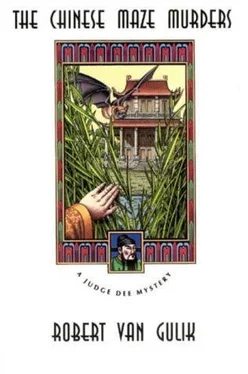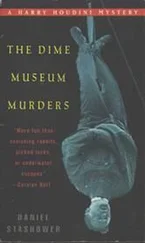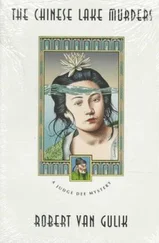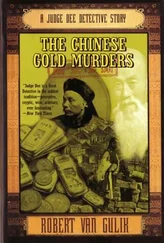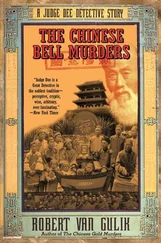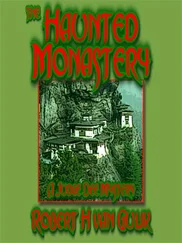Next to these implements one will often see on top of the bench the large square seal of the tribunal, and the gavel. The latter is not shaped like a hammer as in the West. It is an oblong, square piece of hardwood of about one foot long. In Chinese it is significantly called ching-t'ang-mu [3] 'Wood that frightens the hall'.
The constables stand in front of the dais, facing each other in two rows on left and right. Both plaintiff and accused must kneel on the bare flagstones between these two menacing rows, and remain so during the entire session. They have no lawyers to assist them, they may call no witnesses, so their position is generally not an enviable one. The entire court procedure was in fact intended to act as a deterrent, impressing on the people the awful consequences of getting involved with the law.
The magistrate's private office was usually located at the back of the court room, separated from the dais by a screen.
It is a fundamental principle of ancient Chinese law that no criminal can be pronounced guilty unless he has confessed to his crime. To prevent hardened criminals from escaping punishment by refusing to confess even when confronted with irrefutable evidence, the law allows the application of legal severities, such as beating with whip and bamboo, and placing hands and ankles in screws. Next to these authorized means of torture magistrates often apply more severe kinds. If, however, the accused should receive permanent bodily harm or die under excessive torture, the magistrate and the entire personnel of his tribunal are punished, often with the extreme penalty. Most judges, therefore, depend more upon their shrewd psychological insight and their knowledge of their fellow men than on the application of torture.
All in all the old Chinese system worked reasonably well. Sharp control by the higher authorities prevented excesses, and public opinion acted as another curb on wicked or irresponsible magistrates. Capital sentences had to be ratified by the Throne and every condemned criminal could appeal to the higher judicial instances, going up as high as the Emperor himself. Moreover, the magistrate was not allowed to interrogate any accused or witness in private, all his hearings of a case including the preliminary examination had to be conducted in the public sessions of the tribunal. A careful record was kept of all proceedings and these reports had to be forwarded to the higher authorities for their inspection.
Readers of 'Dee Goong An' have inquired how it was possible that the scribes accurately noted down the court proceedings without the use of shorthand. The answer is that the Chinese literary language in itself is a kind of shorthand. It is possible, for instance, to reduce to four written ideographs a sentence that counts say twenty or more words in the colloquial. Moreover there exist several systems of running handwriting, where characters consisting of ten or more brush strokes can be reduced to one scrawl. While serving in China I myself often had Chinese clerks make notes of complicated negotiations conducted in Chinese and found their record of astonishing accuracy.
In most Chinese detective novels the magistrate is engaged in solving three or more totally different cases at the same time. This interesting feature I have retained in the present novel. In my opinion Chinese crime stories in this respect are more realistic than ours. A district had quite a numerous population. It is therefore only logical that often several criminal cases had to be dealt with at the same time.
In this novel I have followed the Chinese time-honoured tradition of adding at the end of the story a detailed description of the execution of the criminals. Chinese sense of justice demands that the punishment meted out to the criminal should be set forth in full detail. I also adopted the custom of Chinese writers of the Ming Dynasty of describing in their novels men and life as they were in their own time, although the scene of their plots is often laid in former centuries. The same applies to the illustrations of this novel, which reproduce customs and costumes of the Ming period (A.D. 1368-1644) rather than those of the T'ang Dynasty.
I may add that 'Judge Dee' is one of the great ancient Chinese detectives. He was a historical person, one of the well known statesmen of the T'ang dynasty. His full name was Ti Jen-chieh and he lived from 630 till 700 A.D. Later he became a Minister of the Imperial Court and through his wise counsels exercised a beneficial influence on affairs of state. It is chiefly because of his reputation as a detector of crimes, however, that later Chinese fiction has made him the hero of a number of crime stories which have only very slight foundation in historical fact.
I borrowed three plots from three different 16th century Chinese collections of crime and mystery stories. In the original none of these three plots bears any relation to Judge Dee or 'Dee Goong An'. Since, however, through my translation of 'Dee Goong An', the reader has become familiar with Judge Dee and his four assistants, those three plots have now been re-written as one continuous story centering round that famous ancient Chinese master-detective. Judge Dee could be introduced into this story without much difficulty, for the magistrate-detective figures in all old Chinese crime novels. The type is more important than the name, in fact it makes little difference whether a crime is solved by 'Judge Pao', 'Judge Peng', 'Judge Shih' or 'Judge Dee'.
The 'Case of the Sealed Room' was suggested by an anecdote concerning Yen Shih-fan, a notoriously wicked statesman of the Ming period who died in 1565 A.D. It is said that he invented a special writing brush capable of ejecting a deadly missile when heated near a candle (cf. A. Waley's introduction ot the English translation of'Chin P'ing Mei', page VIII). The original story states that Yen Shih-fan used this 'loaded writing brush' as a defensive weapon, to be used should one of his many enemies surprise him writing in his library and if no other weapon was at hand. I described such a 'loaded brush' as a weapon of attack and wrote a new story around it dealing with delayed vengeance, a motif not uncommon in Chinese novels. It should be added that when a new writing brush is to be used, the writer must first burn off the superfluous hairs
around the point. To do this he holds it to a flame keeping the shaft horizontal to his eye. There is thus a good chance that a missile projected from the end of the brush will hit his face. Even if the wax holding the coiled spring inside the shaft should not melt during the actual trimming process, the writer will still have little chance of survival once he begins to use his brush, since his head would usually be bent over the paper and therefore be in the direct line of fire. This is indeed what happened to General Ding in the present novel.
Quite another motif is worked out in the 'Case of the Hidden Testament'. This case is based on a well-known ancient Chinese plot. A brief version occurs in the T'ang-yin-pi-shih, a collection of ruling cases compiled in 1211 A.D.; cf. my translation entitled 'T'ang-yin-pi-shih, Parallel Cases from under the Peartree, a 13th century manual of Jurisprudence and Detection' (Sinica Leidensia Vol. X, Leiden 1956), page 177, Case 66-B. Another brief version is found in the famous 16 th century collection of crime stories Lung-t'u-kung-an which describe the exploits of the master-detective Pao-kung who lived during the Sung Dynasty. There the story bears the title of Ch'e-hua-chou 'The Taking apart of the Scroll Picture'. A more elaborate version is given in the popular 17th century collection of Chinese stories Chin-ku-ch'i-kuan; it is inserted there as the third tale, entitled T''eng-ta-yin-kuei-tuan-chia-szu 'Magistrate T'eng 's marvellous solution of the Inheritance Suit'. In the original story the real testament is found hidden in the scroll's mounting, the clues contained in the picture itself are an embellishment I have added. I also added the new plot of the maze mystery which – as far as I know – does not occur in ancient Chinese detective stories although mazes are occasionally mentioned in the description of Chinese palaces. The design of the maze reproduced in the present story is in reality that of the cover of a Chinese incense burner. It is an old Chinese custom to place a thin plate of copper with a cut-out and continuous design, on top of a vessel filled to the brim with incense powder. When the powder is lighted at one end of the design, it slowly burns on like a fuse following the design. During past centuries, there were published in China a number of books reproducing various designs of this kind, usually representing some auspicious phrase, and often of great ingenuity. The design utilized in the present story was borrowed from the Hsiang-yin-t'u-k'ao, a book on this subject published in 1878.
Читать дальше
